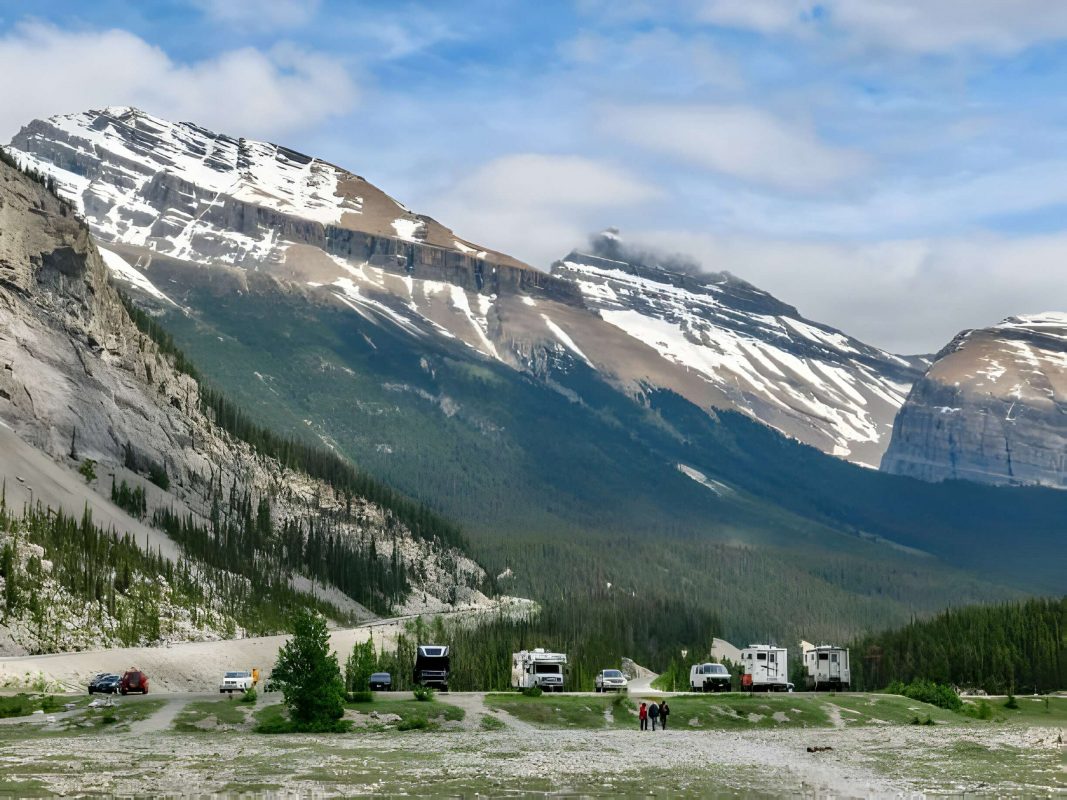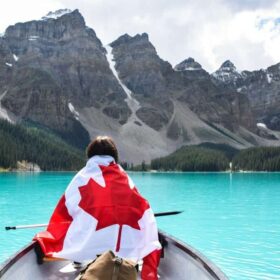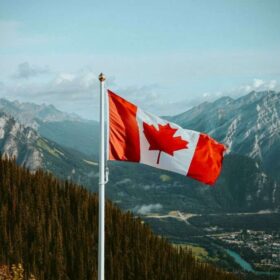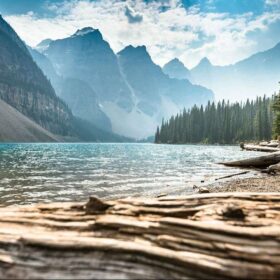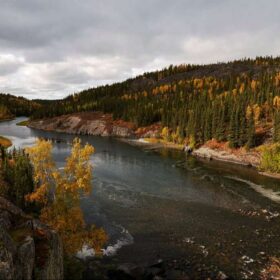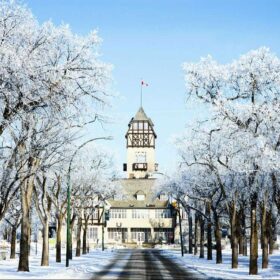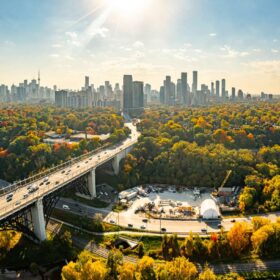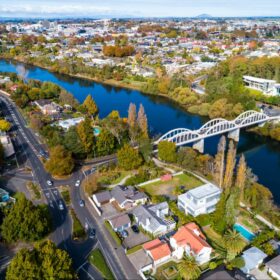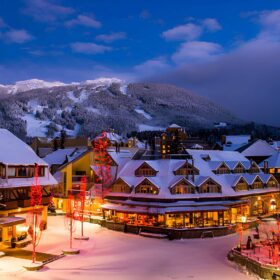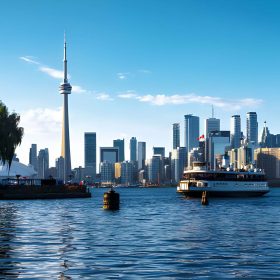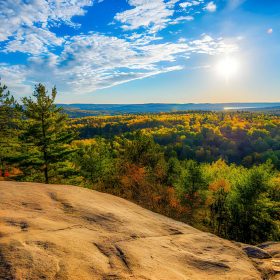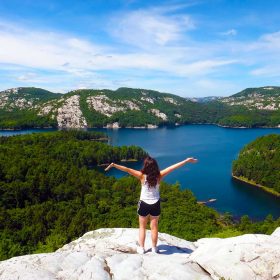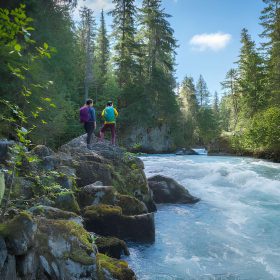Banff National Park stands as one of Canada’s premier parks and should be a top priority on everyone’s list of things to do in the Canada. This park offers a diverse range of attractions, including cold clear rivers, cobalt-colored lakes, glaciers, and dense pine forests teeming with wildlife. It is an ideal destination for camping enthusiasts.
While many visitors engage in windshield tourism, making stops at Banff townsite, Lake Louise, Moraine Lake, and various points along the Icefields Parkway, those seeking the best experience slow down and plan experiences in the park. The most effective way to achieve this is by pitching a tent or parking an RV in some of the most remarkable Canadian campgrounds.
Imagine waking up in the morning, emerging from your tent, and witnessing the stunning Athabasca Glacier glistening in the early light. Savor your coffee at the edge of a lake with a mesmerizingly blue hue, leaving you momentarily speechless. Finally, as night falls, let the soothing sounds of a creek and the rustling of the wind through the pines lull you to sleep.
The nine campgrounds listed below offer diverse experiences. For convenience and easy access to the top spots, consider camping near Banff Townsite at Tunnel Mountain or at Lake Louise. For a more natural experience with fewer amenities, explore Waterfowl, Rampart, or Mosquito Creek campgrounds. If you’re an adventurous camper unafraid of changing weather and chilly nights, set up your tent at Wilcox and enjoy the Athabasca Glacier all to yourself.
For those new to camping, Parks Canada has introduced alternative options in the campgrounds, such as the innovative oTENTik structures—a hybrid between a tent and a cabin. These structures come equipped with beds, floors, lights, and a heat source.
Campgrounds closest to the towns of Banff and Lake Louise typically have electricity and running water and can be reserved. Those farther afield are generally first-come, first-served and lack services. Keep reading for a detailed understanding of the best campgrounds in Banff National Park.
1. Waterfowl Lakes
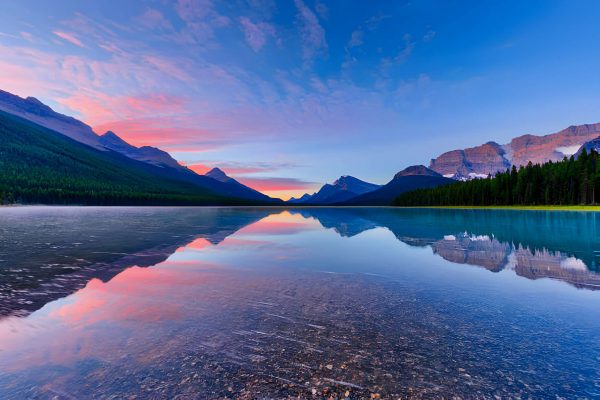
Overlooking the breathtaking Lower Waterfowl Lake, this campground boasts one of the most picturesque settings in the park. Situated 57 kilometers up the Icefields Parkway from Lake Louise, it caters to those seeking a serene camping experience and an appreciation for natural attractions, rather than the convenience of proximity to the towns of Banff or Lake Louise.
Nestled in a wooded area off the main highway, the campground offers 116 sites, all available on a first-come, first-served basis. The well-spaced sites provide a sense of privacy. Comfort stations include a mix of three pit (dry) toilets and one equipped with flush toilets, sinks, and hot and cold running water.
The campground’s narrow roadways make it more suitable for RVs under nine meters (30 feet) in length. Communal cook shelters, featuring stoves and picnic tables, are accessible. On Saturdays, the campground hosts an interpretive program at the outdoor theater.
Surrounded by tall trees and bordered by a small creek, the campground features a pleasant hiking trail connecting Upper Waterfowl Lake and Lower Waterfowl Lake. Other trails departing from the campground include the Cirque Lake hike and the Chephren Lake trail.
This campground stands as one of the best-positioned in the entire park for hiking and exploring the Icefields Parkway. The stunning Peyto Lake is a short drive away, Bow Lake is nearby, Lake Louise is just over 40 minutes away, and the Athabasca Glacier is an hour’s drive.
Open from mid-June to the first week of September, the Waterfowl Lakes campground is a popular summer destination. It’s advisable to have a backup plan in case spots are unavailable.
2. Silverhorn
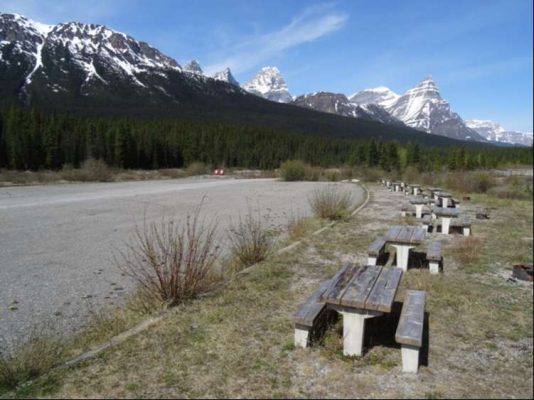
Silverthorne Campground stands out among Icefields Parkway camping spots, offering some of the most spectacular views. What sets it apart is its location in a broad valley on level ground, with no obstructions between sites. The campground comprises 45 sites, all operating on a first-come, first-served basis.
Designed primarily for RV travelers, this campground’s expansive layout and easy accessibility cater to even the largest rigs, accommodating lengths up to 20 meters or 70 feet. However, if you’re tent camping, it’s advisable to explore alternatives like Waterfowl Lakes.
Facilities are basic, featuring pit toilets, and there is no running water available. Nevertheless, for RV users, these limitations are unlikely to pose any challenges.
Situated 52 kilometers from Lake Louise, Silverthorne Campground welcomes visitors from the first week of June to the last week of September.
3. Tunnel Mountain Village I, II, and Trailer
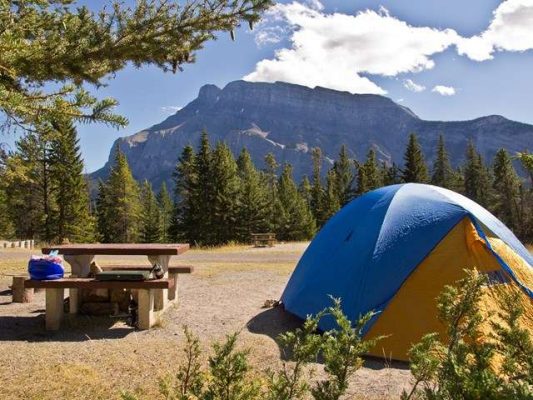
Envision camping atop a mountain, and that’s essentially what awaits you at any of the Tunnel Mountain campgrounds. Positioned on a broad plateau with expansive areas, the campground offers breathtaking views in all directions, particularly from numerous sites in the Trailer Court.
This campground serves as an ideal base to park your rig or car and explore the attractions of Banff townsite for a few days. Nearby points of interest include the Sulphur Mountain Gondola, the Hot Springs, the Cave & Basin Historical Site, and shopping on Banff Avenue. The park facilitates easy exploration with convenient and user-friendly ROAM public transit, with stops right at the campground entrance.
Comprising three grouped campgrounds, Village 1 and 2 cater to RVs and tents, totaling 808 sites. Village 1 features 618 unserved sites, while Village 2 offers 188 sites, all equipped with electricity (15, 30, and 50 amps). Additionally, Village II provides 34 tent-only walk-in sites. The Trailer Court, aptly named, boasts 321 full-service sites with water, sewer, and electrical hookups (15 and 30-amp service), with campfires not permitted.
The campground facilities include comfort stations with flush toilets and hot showers, communal cook shelters, fire pits, and interpretive services. For those without camping gear, oTENTik structures are available for rent.
Tunnel Mountain Village II operates year-round, while the Trailer Court and Tunnel Village I are open from the first week of May through the first week of October.
4. Icefield – Tent
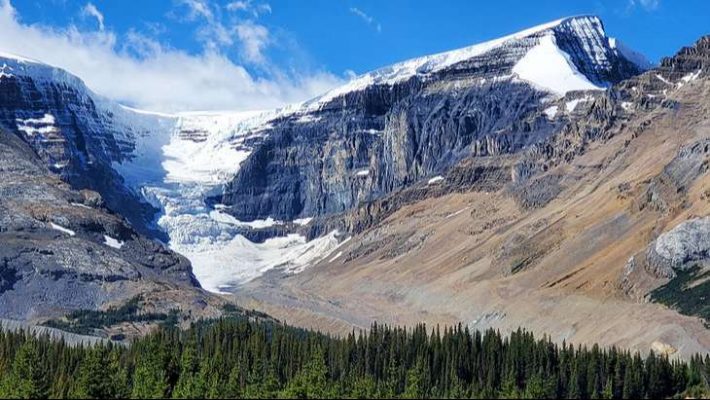
Arguably the most picturesque among all the campgrounds in the mountain national parks is the Icefield Tent Campground. Positioned on a hillside with sweeping views of the Athabasca Glacier, the scenery from here is awe-inspiring.
Try to secure one of the 33 first-come, first-served sites, and it will be an unforgettable experience. The sites feature level tent pads and include a picnic table, a fire ring, and a parking spot. Five of the 33 sites are accessible by walk-in only, crossing a small bridge over the creek.
A communal cook stove is situated in a rustic building, ensuring your dinner companions will be fellow mountain enthusiasts from around the world. Keep in mind that at this elevation (around 2,000 meters or 7,000 feet), cooking your food may take longer.
The Icefield Tent Campground operates from the first week of June through the second week of October, depending on the year and the presence of lingering or early snow.
5. Rampart Creek
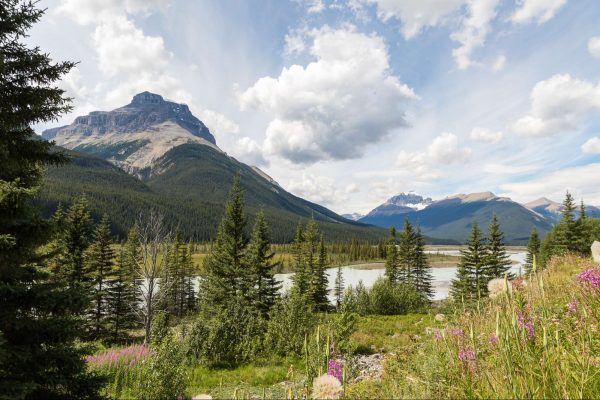
Rampart Creek is a charming, compact campground featuring only 50 sites. The North Saskatchewan River flows alongside the campground, and some sites are positioned right along the riverbank. Situated 88 kilometers from Lake Louise up the Icefields Parkway, this campground offers a fairly basic experience but provides communal cook shelters with wood stoves and picnic tables, creating opportunities to mingle with fellow campers from around the world.
All sites are available for online reservation in advance from early June through mid-September. Outside of these periods, sites operate on a first-come, first-served basis. The comfort stations include pit toilets, and water is accessible. For those with RVs, the campground is recommended for rigs under 35 feet in length.
Basic camper supplies, a restaurant, gas station, and hotel are conveniently located just south of Rampart Creek at Saskatchewan River Crossing. The campground is open from the first week of June to mid-October.
6. Mosquito Campground
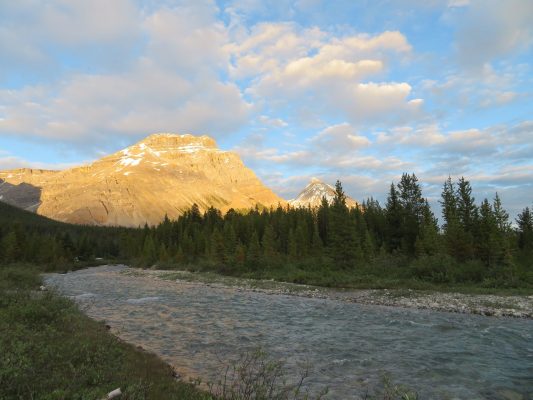
As you lay down each night at Mosquito Campground, the soothing sound of nearby Mosquito Creek will lull you to sleep. The campground offers 32 sites on a first-come, first-served basis, providing a convenient camping spot just 24 kilometers from the attractions of the Lake Louise area, with Yoho National Park also nearby.
Featuring a mix of tent sites and spaces suitable for RVs, this campground, with its limited number of sites, offers a tranquil environment for a night’s stay or a longer retreat. Nearby, you’ll discover excellent hikes and lakes to explore.
Contrary to its name, Mosquito Creek does not have any more mosquitoes than other campgrounds in the park, so there’s no need for alarm. Standard amenities include pit toilets, communal cook shelters, and water facilities.
Mosquito Creek Campground is open from the first week of June through the middle of October.
7. Wilcox Campground
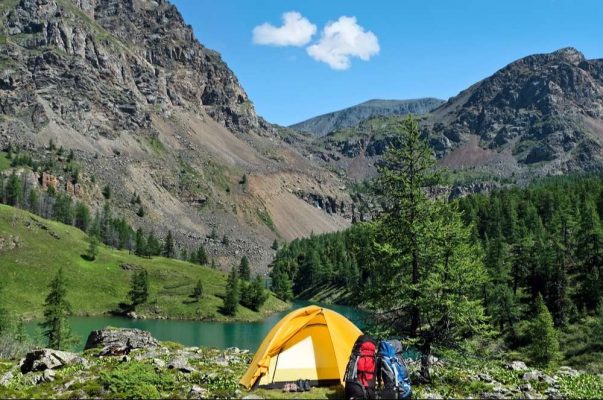
Located just a few kilometers over the border in Jasper National Park but often included in the typical sightseeing tour of Banff National Park, Wilcox Campground is an ideal accommodation for hiking enthusiasts. The renowned Wilcox Pass hike begins at the entrance roadway of the campground.
A relatively small campground with 46 sites, it is best suited for tent camping and small RVs under eight meters or 27 feet. Due to the campground’s terraced layout, size limits are in place to ensure level and well-spaced sites with excellent privacy.
Comfort stations consist of pit toilets, and drinking water is accessible through three taps located at the bottom, mid, and top levels of the campground.
The campground offers spectacular views of Mount Athabasca (3,491 meters, 11,453 feet) and Hilda Peak (3,058 meters, 10,032 feet) across the valley floor. Aside from the Wilcox Pass hiking trail, visitors can explore the Parker Ridge hike, providing views of the Saskatchewan Glacier—two of the best hikes in Banff National Park. Only a kilometer away is the renowned Athabasca Glacier and its visitor center.
Given the high altitude of nearly 2,000 meters (7,000 feet), campers should be prepared for chilly nights, even during summer. Wilcox Campground is typically open from the first week of June until the third week of September, but these dates may vary with late spring or early fall conditions.
8. Lake Louise Campground
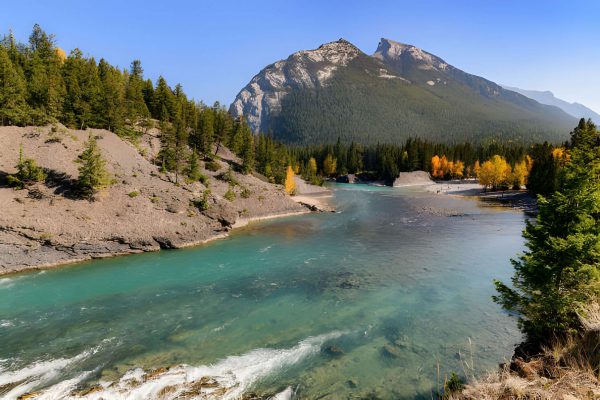
Lake Louise camping offers two distinct experiences: tent camping in a charming, wooded setting alongside the swiftly flowing Bow River and RV camping on the opposite side of the river, arranged side by side within the forest.
The Lake Louise Tent Campground features 206 sites dispersed across 12 loops, providing ample space and privacy at each site. Equipped with running water, flush toilets, and hot showers, the tent area is enclosed by an electrified bear-proof fence for camper safety.
On the other hand, the Lake Louise Trailer Campground offers 189 sites with sewer, water, and electricity amenities. Not surrounded by the electrified fence, this area requires RVs to be fully hard-sided, with a maximum length of 22 meters. Both campgrounds share the same entrance gate.
Conveniently located within walking distance of the Lake Louise townsite, the campgrounds provide access to a grocery store, various retail outlets, and excellent restaurants. A short drive away are the renowned Lake Louise and Moraine Lakes, along with breathtaking hiking trails. A pleasant walking trail along the Bow River connects to other trails around town.
Both Lake Louise campgrounds benefit from the Park and Ride Connector service, a free bus that stops at the campgrounds and travels to Moraine Lake and Lake Louise.
While the Lake Louise Trailer Campground is open year-round, the tent campground welcomes visitors from the first week of June through the end of September.
FAQs
Q: Can I camp in Banff National Park without a reservation?
A: While some campgrounds allow for first-come, first-served camping, it’s highly recommended to make reservations in advance, especially during peak seasons, to secure your spot.
Q: What wildlife might I encounter while camping in Banff?
A: Banff is home to various wildlife, including bears, elk, and mountain goats. Respect their natural habitat, keep a safe distance, and follow wildlife safety guidelines.
Q: Are there any restrictions on campfires in Banff?
A: Campfire regulations vary by campground and season. Check the park’s guidelines and restrictions before planning a campfire, and always prioritize fire safety.
Q: Are there alternatives to camping for accommodation in Banff?
A: Yes, Banff offers various lodging options, including hotels, cabins, and resorts. Explore nearby accommodations for a comfortable stay if camping isn’t your preference.
Q: What’s the best time of year to visit Banff for camping?
A: The summer months (June to August) are popular for camping, offering pleasant weather and longer daylight hours. However, consider the shoulder seasons for fewer crowds and a more serene experience.

